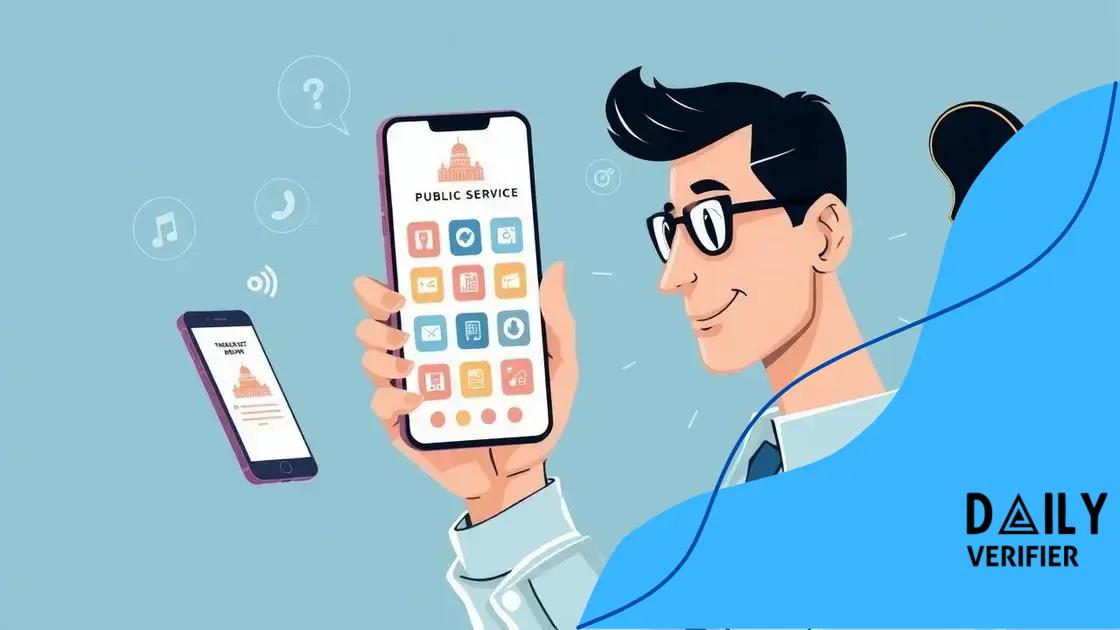Gov apps checked for access to enhance transparency

Government apps checked for access significantly enhance citizen engagement by improving accessibility through user-friendly designs, multilingual support, AI integration, and strong data security measures.
Gov apps checked for access are crucial for fostering transparency in the public sector. Have you ever wondered how easily you can access vital government services? In this article, we’ll dive into the significance of these apps and their role in enhancing communication between citizens and their government.
Understanding the importance of government apps
Understanding the importance of government apps is crucial in today’s digital age. These applications help streamline processes and improve communication between the government and its citizens. When designed effectively, government apps can provide essential services at the fingertips of users.
Enhancing Citizen Engagement
By utilizing government apps, citizens gain better access to information and services. This increased accessibility promotes active participation in civic matters. With features like updates on local events, public services, and feedback opportunities, these apps can transform traditional communication.
Key Benefits of Government Apps
- Convenience: Users can access services anytime, reducing wait times.
- Transparency: Information about policies and procedures is readily available.
- Feedback Mechanism: Citizens can share their experiences and suggestions directly.
- Cost-Effective: Reduces administrative burdens and improves efficiency.
The accessibility of government apps also addresses common barriers. Many individuals face challenges when trying to navigate bureaucratic processes. Therefore, simplifying these interactions through technology ensures that more people can engage with their government.
Furthermore, as more citizens embrace digital tools, the demand for user-friendly government apps grows. These platforms should be designed with the end user in mind, ensuring navigation is simple and intuitive. By creating a positive user experience, the government can foster greater trust and satisfaction.
Building Trust and Accountability
When citizens can easily access government services, trust in public institutions increases. They feel more connected to their representatives and more informed about policies affecting their lives. This trust is essential for a thriving democracy.
In summary, government apps represent a significant step toward modernizing public services. As these apps continue to evolve, they have the potential to reshape how citizens interact with their government and access vital resources.
How accessibility impacts citizen engagement
How accessibility impacts citizen engagement is vital in understanding how government apps work. When services are easy to reach, people are more likely to use them. This increased usage strengthens the connection between citizens and their government.
The Role of Usability
Usability plays a big part in accessibility. If government apps are user-friendly, they encourage more participation. Consider how intuitive design helps people find what they need quickly. A well-designed app can guide users through processes, making tasks simpler.
Importance of Multilingual Options
Offering government apps in multiple languages ensures that everyone can access services. This inclusivity allows people from different backgrounds to engage with their government. It helps bridge the communication gap and can lead to higher overall satisfaction.
- Wider Reach: Non-English speakers can access essential services.
- Community Trust: Inclusivity fosters a sense of belonging.
- Better Feedback: More voices can contribute to service improvements.
Another important component is adapting apps to meet the needs of individuals with disabilities. Features like voice commands, screen readers, and larger text sizes make a significant difference. These adaptations ensure that everyone, regardless of ability, can engage with their government efficiently.
Additionally, providing clear instructions and support within apps further enhances accessibility. When users encounter difficulties, having help readily available can prevent frustration. Therefore, investing in training for users can further improve their engagement.
Impact on Civic Participation
With improved accessibility, civic participation naturally increases. Citizens feel more empowered to participate in local policies, attend meetings, and provide feedback. When engagement opportunities are clear and available, people are likely to take action.
In conclusion, enhancing accessibility within government apps creates a ripple effect, fostering more significant engagement. It builds a stronger relationship between citizens and their government, ultimately strengthening democracy.
Evaluating the effectiveness of gov apps

Evaluating the effectiveness of gov apps is essential to ensure they meet the needs of citizens. An effective app should be user-friendly, provide relevant information, and encourage civic engagement. Understanding how well these apps perform can help improve them over time.
Measuring User Satisfaction
One way to evaluate effectiveness is by measuring user satisfaction. Surveys and feedback forms can be used to gather insights from users. Questions about usability and features can reveal how satisfied citizens are with the app.
Key Performance Indicators (KPIs)
Governments should also focus on specific key performance indicators (KPIs) to gauge the success of their apps. Examples of effective KPIs include:
- Number of Downloads: This indicates the app’s popularity.
- User Retention Rates: A high retention rate suggests users find the app helpful.
- Frequency of Use: Regular usage shows the app meets ongoing needs.
- Feedback Response Times: How quickly the government addresses user feedback matters for overall satisfaction.
Another important factor is analyzing how effectively the app improves access to services. Data on how many users access information or complete tasks can show the app’s impact. If many people use the app to find local services, it likely serves its purpose well.
Usability testing is also a practical approach to evaluating effectiveness. By observing users as they navigate the app, developers can identify pain points. This hands-on method helps refine features to enhance the overall experience. Additionally, incorporating real user stories can highlight how the app benefits citizens.
Continuous Improvement
Continuous evaluation and improvement are essential. Governments should regularly update their apps based on user feedback and changing technology. This proactive approach ensures that the apps remain relevant and effective for their users.
In conclusion, evaluating the effectiveness of gov apps helps ensure they meet user needs. Regular assessment through user feedback, KPIs, and usability testing can lead to significant improvements that benefit the entire community.
Common barriers in accessing government apps
Common barriers in accessing government apps can hinder the ability of citizens to utilize important services. Understanding these challenges is crucial to improving accessibility and user experience. Several factors often contribute to these barriers, making it difficult for users to engage effectively.
Technical Issues
Technical problems can create significant obstacles for users. Slow loading times or app crashes can frustrate users, leading to a lack of trust in the application. If government apps do not function smoothly, users may abandon them altogether.
Lack of Digital Literacy
Another barrier is the varying levels of digital literacy among the population. Many individuals may struggle with navigating apps due to limited experience with technology. Providing tutorials or guides can help bridge this gap and empower users.
- Training Opportunities: Offering workshops or online tutorials can enhance skills.
- Support Services: Helplines or chat support can assist users who are stuck.
- Clear Instructions: Easy-to-follow guides can make a big difference.
Cultural differences may also impact how individuals access and use apps. Language barriers can prevent non-native speakers from fully engaging with the app. Therefore, providing multilingual options is essential for inclusivity.
Moreover, design accessibility is vital. If an app is not intuitive or lacks features for people with disabilities, it will lead to frustration. Adaptations, such as voice commands or larger text options, can significantly improve the user experience.
Privacy Concerns
Privacy and security concerns represent another barrier to accessing government apps. Some users may hesitate to share personal information due to fears of data misuse. Building trust with the community is essential for encouraging app usage.
To address these challenges, it is important for governments to take proactive steps. Regularly obtaining user feedback can highlight specific barriers that need to be resolved. By focusing on these issues, governments can create more accessible and effective services for all citizens.
Future trends in government app accessibility
Future trends in government app accessibility will focus on enhancing user experience and inclusivity. As technology evolves, so does the potential for government apps to serve a broader audience. It is essential to stay ahead of these trends to ensure all citizens can benefit from digital services.
Integration of Artificial Intelligence
Artificial intelligence (AI) will play a vital role in improving accessibility. By using AI, government apps can offer personalized experiences. For example, chatbots can assist users in real-time, guiding them through processes and answering questions.
Enhanced Multilingual Support
As communities become more diverse, offering multilingual support in government apps will be crucial. This can help break down language barriers and ensure everyone can access essential services. Future apps will likely include automatic translation features that allow users to interact in their preferred language.
- Real-time Translation: Instant translations will improve communication.
- Audio Options: Voiced instructions can aid users who prefer auditory guidance.
- Cultural Sensitivity: Tailoring content to fit cultural needs will foster inclusiveness.
Furthermore, the design of government apps will likely shift towards simplicity and clarity. Apps will prioritize user-friendly interfaces, making navigation intuitive for all users, including those with disabilities. Features like voice commands and customizable display settings could become standard.
In addition, collaboration between governments and tech companies may lead to more innovative solutions. This partnership can bring fresh ideas and technologies that enhance accessibility, ultimately creating a more seamless experience for users.
Focus on Data Security and Privacy
As accessibility improves, so too must data security measures. Users need to feel safe when accessing government apps. Government agencies will likely implement stronger security protocols to protect user information while maintaining ease of access.
By anticipating these future trends, governments can create inclusive digital platforms that cater to diverse populations. Staying proactive in app development ensures that everyone can engage with their government efficiently and effectively.
In summary, government apps are vital for enhancing accessibility and engagement among citizens. As technology progresses, it is essential for these applications to adapt and meet the diverse needs of the population. By focusing on accessibility, leveraging AI, and ensuring data security, governments can create more inclusive platforms. The future of government apps looks promising, and with the right improvements, they can foster stronger connections between citizens and their governments.
FAQ – Frequently Asked Questions about Government Apps Accessibility
What are the main barriers to accessing government apps?
Common barriers include technical issues, lack of digital literacy, language differences, and privacy concerns.
How can government apps improve accessibility?
Government apps can improve accessibility by using user-friendly designs, offering multilingual support, and ensuring compliance with accessibility standards.
What role does AI play in enhancing government app usability?
AI can provide personalized experiences, help guide users through processes, and answer questions in real-time, improving overall user satisfaction.
Why is data security important for government apps?
Data security is essential to protect user information, build trust, and encourage more citizens to use the apps without fear of data breaches.






